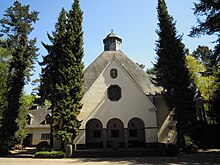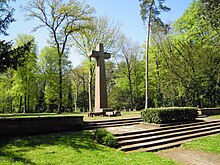Forest cemetery Oberrad
The Oberrad forest cemetery is located in the Sachsenhausen district of Frankfurt and was laid out in 1914 south of the Oberrad district on the edge of the city forest and west of the Tellersiedlung .
layout
With 20.5 hectares, the Oberrad forest cemetery is the third largest burial area in Frankfurt after the main cemetery and the Westhausen cemetery . There are around 7000 graves. It was created within a forest area of the Frankfurt city forest and is characterized by a relatively dense and well-tended tree population with horticultural grave areas.
In addition to the largely natural forest areas, there are also large clearings with war graves , which are characterized by the regular arrangement of the gravestones. The graves are mostly on both sides of elongated lawns. Two of the fields are arranged along an axis in the center of the cemetery. Other special features are a Muslim burial ground and several mourning groves. In the small forest areas, urns are buried anonymously in the immediate vicinity of a tree, similar to a natural burial .
At the cemetery entrance in Burgenlandweg 10 there is a parking lot, company building and a bus stop for lines 81 and 82. Directly behind it is the historic mourning hall . Widely ramified, mostly winding paths open up the eight tubs .
War casualty fields
The cemetery contains the graves of 756 Dutch war dead from World War II as well as 31 German soldiers from World War I and 2874 German soldiers from World War II.
On the Dutch Ehrenfeld (Dutch: erebegraafplaats) Dutch are buried in the Nazi until 1945 Germany in the period from 1940 as forced laborers died. It is located in the north of the cemetery and consists of 756 graves with white tombstones and a plaque with 242 names of victims who could not be buried in the field of honor. The bronze sculpture The Falling Man commemorates the victims with a Dutch inscription. The Ehrenfeld was inaugurated in 1956. At the initiative of the Dutch War Graves Foundation, seven Dutch fields of honor were created in Germany during this period.
The grave fields of the German dead are in the center of the cemetery. The wide area runs in an east-west direction and is characterized by a high cross. It consists of roughly hewn red sandstone, which is also used for the tombstones. Below the crucifix, an inscription commemorates the dead and urges peace.
Mourning hall
The funeral hall is designed in the style of classicism . The high slate roof is structured by dwelling houses that rest on columns. The chapel has 60 seats. The building is a cultural monument according to the Hessian Monument Protection Act as is the fence and gate from the construction period.
Listed graves
The following graves are listed:
| image | Won | Name (s) | year | Stonemason | description |
|---|---|---|---|---|---|
 |
1 A 10 | bird | 1921 | Neoclassical stele between corner posts made of artificial limestone | |
 |
1 A 11 | Steinheimer Wolf | 1921 | JeanWolf | Neoclassical aedicula with fluted pilasters under a triangular limestone pediment. On the side wings, which end with volutes, there are oval writing fields in bronze frames. The central niche is decorated with a cross backed with roses. |
 |
1 A 8-8a | Jung-Nees | 1933 | Simple stele on a trapezoidal floor plan made of artificial limestone | |
 |
1 B 14 | Rib | 1924 | Karl Zorbach | Neoclassical stele with Baroque elements made of artificial stone shell limestone. |
 |
1 B 5 | Kuppenheim | 1920 | Gebr. Hasenbach | Neoclassical monument made of Kirchheim shell limestone in the form of an altar. The altar plate is carried by caryatids . There is a fully sculptural group of figures of the Pietà motif. |
 |
1 B 8 | Hofmann-Neumann | 1929 | Jean Schad | Three-part wall stele made of polished Bluberg granite. In the center is a bronze relief of a mourning female figure in front of an altar. |
 |
1 E 13 | Dear | Stele in neo-renaissance forms made of marble in reuse. | ||
 |
1 G 1 | Brighter | 1915 | Wagner brothers | Neoclassical aedicule-like stele with fluted pilasters, Ionic capital, rosette-adorned architrave and a meander frieze made of limestone leading to the roof. |
 |
1 G 35 | king | 1921 | Jos. Freudenberger | Neoclassical limestone stele framed by rounded pilasters with an Ionic capital. In the segment arch gable there are reliefs of a cross, surrounded by floral ornaments. |
 |
1 H 4 | Young | 1918 | Jakob Dietrich | Neoclassical aedicule of Ionic order over a stepped base. On both sides there are pillars with a limestone flower bowl. |
 |
1 H 12 | White | 1921 | Small aedicle-like limestone stele. | |
 |
1 K 6 | Vault | 1964 | Georg Treser was a city councilor in Frankfurt. The tomb is a prism-shaped simple limestone stele. | |
 |
1 K 23 | Dedecke-Rode | 1919 (1953) | Jakob Dietrich (Heinrich Stiegmann) | Three-part wall stele made of shell limestone. In the segment arch gable there is a relief of a flower basket. Wreath reliefs can be seen on the side pillars. In 1953, two urns made from Krensheim shell limestone were added. |
| 1 M 13 | Paatz | 1925 | Karl Zorbach | Urn stele made of artificial stone shell limestone. | |
| 1 M 34 | Beckert | 1974 | Hans Steinbrenner | Hans-Georg Beckert (1927–1981) was an architect. The tomb is an obelisk-like stele made of red artificial stone. | |
 |
1 O 1 UG | Wislicenus-Haag-Schütz | 1950 | ||
 |
1 O 11 | Müller-Wolfart | 1929 | Karl Zorbach | |
 |
2 A 12 | Reinhard | 1926 | EC clapping | |
 |
2 A 20-22 | Bold | 1927 | Gebr. Wagner | |
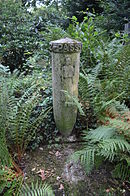 |
2 B 8 | passport | 1930 | Karl Zorbach | |
 |
2 F 3 | chandler | 1920 | Jos. Freudenberger | |
 |
2 F 28 | Krausgrill | 1930 | Ernst Unger | |
 |
2 G 16 | Bender | 1919 | Jean Wolf | |
 |
2 H 26 basement | chandler | 1933 (1949) | O. Ufert | |
| 2 H 14 from | Höfseß | 1920 | Kurt Hoppe | ||
 |
2 Y 1 | Grave complex of the Frankfurt sister association | 1931 | WFC Ohly | |
 |
2 Y 2 | Ludwig | 1924 | F. Hofmeister | |
 |
2 J 6 | Palm | 1931 | E. Zorbach | |
 |
2 J 12 | Surla | 1982 | ||
 |
2 J 13 | Hansen | 1932 | Gebr. Wagner | |
 |
2 J 14 | Barth | 1934 | Gebr. Wagner | |
 |
2 J 15 | Auth | 1937 | Jos. Freudenberger | |
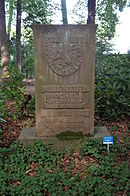 |
2 J 16 | Wochele-Heiner | 1936 | W. Schuessler | |
 |
2 J 17 | Ruhl | 1939 | Th. Sigl | |
 |
2 J 27 | Seum | 1939 | Jos. Freudenberger | |
 |
2 J 33 UG | Stemmer | 1938 | F. Hofmeister | |
 |
2 J 34 | Bilhardt | 1939 | EC clapping | |
| 2 J 37 | Seeger | 1942 | Martin Ricker | ||
 |
2 J 44 | Thinner | 1940 | ||
 |
2 J 50 | Minstrel | 1948 | Ludwig Jakob | |
 |
2 J 54 | Hartoch-Weiss | 1993 | F. Hofmeister | |
 |
3-10 | Kessler | 1960 | Hermann Reichert | |
 |
3-40 | Trautmann | 1942 | Heinrich WA Wolf | |
 |
3-50 | Young Ludwig | 1934 | H. Dammann + H. Rochlitz, Berlin-Grunewald | |
 |
3-107 | Borck | 1944 | ||
 |
4 - 443 | Dannemeyer | 1960 | Heinz Moeritz | |
 |
4 - 446 | Nerlich | 1959 | Alois Schneider | |
 |
4 - 447 | Reinhardt | 1960 | Hammerschmidt, Niederselters | |
 |
4 - 448 | John | 1957 | Heinz Moeritz | |
 |
4 - 449 | Ganns | 1958 | Nau & Mahr | |
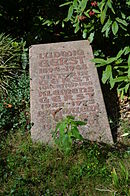 |
4 - 450 | Barley | 1966 | Joh. Ferd. Harm | |
 |
4 - 451 | Idle Walke | 1960 | Nau & Mahr | |
 |
4 - 452 | Bayer | 1959 | A. Martin Ricker | |
 |
4 - 453 | Schmitt-Grass | 1959 | Heinrich Stiegemann | |
 |
4 - 454 | Star nail | 1959 | Heinz Moeritz | |
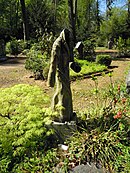 |
4 71 a | Senger | 1997 | Eva Renée Nele | Mantle sculpture on the grave of Valentin Senger |
Personalities
- Rudolf Koch (1876–1934) type designer and graphic artist
- Bruno H. Schubert (1919–2010) entrepreneur, consul and patron
- Valentin Senger (1918–1997) writer, Won VI
Web links
- Oberrad - Waldfriedhof in the appearance of the Frankfurt cemeteries
- Mourning forest Frankfurt-Oberrad
- State Office for Monument Preservation Hessen (Hrsg.): Mourning Hall In: DenkXweb, online edition of cultural monuments in Hessen
- Dutch Wikipedia article about the Ehrenfeld
- Photos of the Dutch field of honor
- Waldfriedhof Oberrad on the website of the Volksbund Deutsche Kriegsgräberfürsorge
literature
- City of Frankfurt am Main: The Cemetery Guide - This and Beyond , 2nd edition, Mammut-Verlag Leipzig 2015
Individual evidence
- ↑ Geoportal Hessen. October 7, 2014, accessed July 1, 2018 .
Coordinates: 50 ° 6 ′ N , 8 ° 44 ′ E
